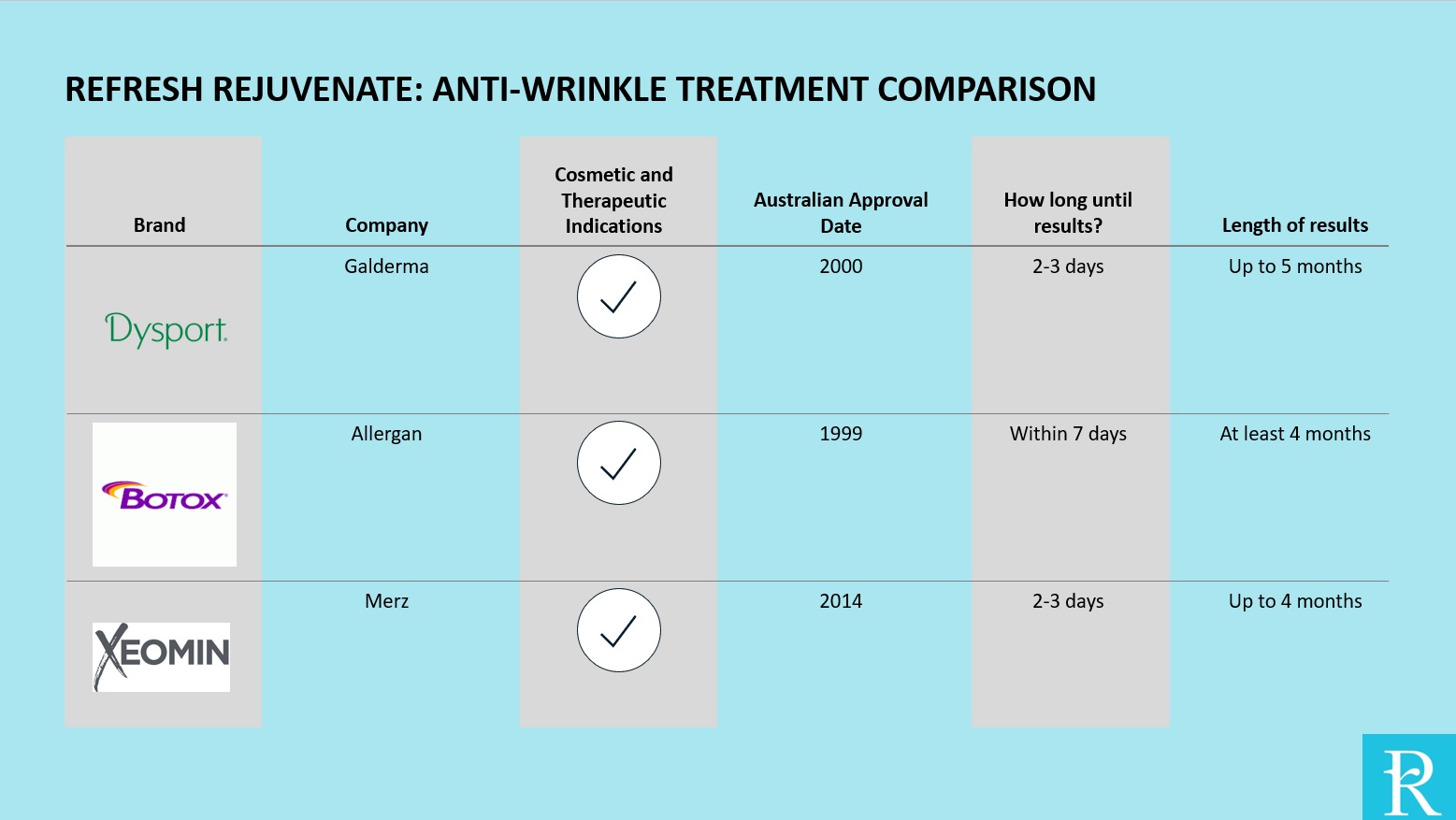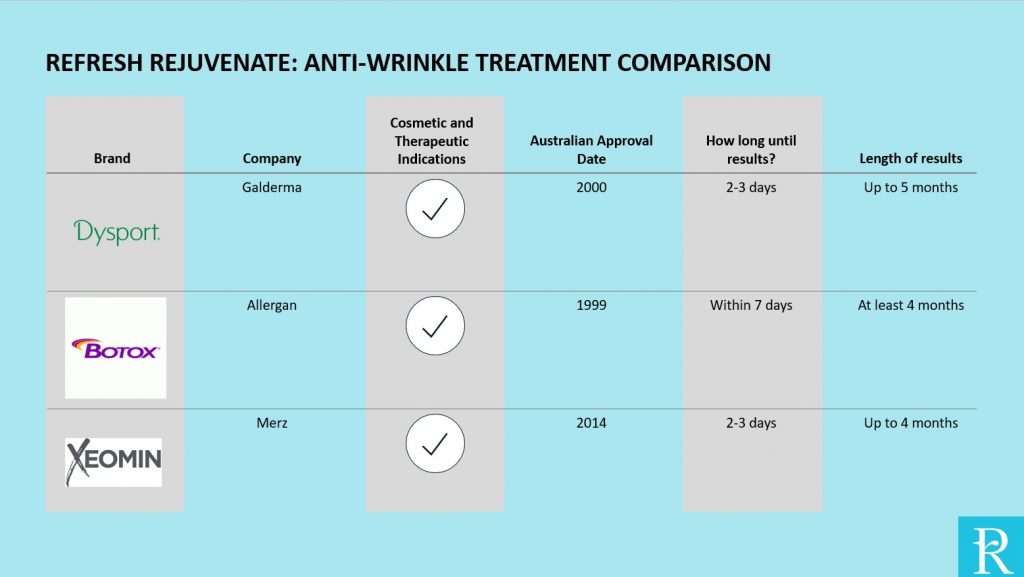
20 Mar 7 facts you didn’t know about anti-wrinkle injections
7 facts you didn’t know about anti-wrinkle injections
From the discovery of anti-wrinkle injections decades ago, to its widespread clinical and cosmetic uses today, this remarkable treatment is a long-standing staple in medicine. Anti-wrinkle injections top lists of the most popular nonsurgical procedures in Australia and abroad year after year. Despite the steady influx of new treatments and products, anti-wrinkle injections aren’t going anywhere — and there’s a lot more to them than meets the eye.
#1 — THERE IS MORE THAN ONE BRAND OF WRINKLE-RELAXING INJECTIONS
There are several brands that fall into the category of injectable wrinkle relaxers in Australia. Each one contains the same primary active ingredient, but they are formulated differently and made by different manufacturers. The results they offer are also subtly different, so it’s important to find an experienced practitioner who is well-versed in the options available.

#2 — THE ROOTS OF ANTI-WRINKLE INJECTIONS GO BACK TO THE EARLY 19TH CENTURY
The active ingredient in anti-wrinkle injections was initially discovered due to an outbreak of food poisoning. In the early 1800s, the German physician Justinus Kerner published research on a wave of foodborne botulism that occurred in a village after residents consumed blood sausages, a local delicacy. Dr Kerner asserted that a toxin that developed within the sausages brought on “Wurstgift” (German for “sausage poison”) and that the toxin, if used correctly, could have therapeutic applications. His work paved the way for the study of the toxin and the eventual development of anti-wrinkle injections in the years to come.
#3 — WE DIDN’T DISCOVER THE TOXIN’S COSMETIC BENEFITS UNTIL THE 1990S
Before they were the world’s most popular wrinkle treatment, anti-wrinkle injections weren’t for wrinkles at all. Their first use was the treatment of strabismus, or crossed eyes. In the 1970s, scientists discovered that the toxin could relax the muscles responsible for making the eyes point in different directions. It received FDA approval for therapeutic use in the United States in 1989. Research on the substance continued into the 1990s, and soon its ability to reduce wrinkles was noticed. The product was rebranded and, in 2002, received its first FDA approval for cosmetic use.
#4 — ANTI-WRINKLE INJECTIONS DON’T WORK FOR EVERY KIND OF WRINKLE
There’s an injectable to treat just about every line on the face, but anti-wrinkle injections aren’t right for all of them. Wrinkle relaxers work by releasing a substance that blocks the signals that travel from nerves to specific muscles. Without these signals, the muscles do not contract, and the skin over them relaxes. Because anti-wrinkle injections work by controlling muscle contractions, they’re only effective on lines caused by muscle movement in the first place (“expression lines” or “dynamic wrinkles”). This type of line is primarily found in the upper face, around the forehead and eyes. Wrinkles caused by sun damage, gravity, reduced skin elasticity and the loss of fat and collagen are called “static”. They’re visible regardless of muscle action, and they’re treated with dermal fillers rather than anti-wrinkle injections. Static lines are often found in the lower region of the face, around the nose, mouth and chin.
#5 — ANTI-WRINKLE INJECTIONS CAN TREAT MORE THAN JUST WRINKLES
We’re continuously discovering new uses for anti-wrinkle injections. Since their introduction as a strabismus treatment, these injections have been approved for many other therapeutic applications, including excessive sweating (hyperhidrosis), migraine headaches, overactive bladder, blepharospasm, limb spasticity and neck pain associated with cervical dystonia. We’ve also expanded our use of them in cosmetic settings. In addition to smoothing crow’s feet, forehead wrinkles and glabellar lines, anti-wrinkle injections can elevate the brows, lift a droopy nasal tip, slim the jaw, correct a gummy smile, enhance the upper lip and more.
#6 — THE FULL EFFECT OF ANTI-WRINKLE INJECTIONS ISN’T IMMEDIATE
Anti-wrinkle injections are often called a “lunchtime procedure”, but don’t expect to see results before you get back to the office. The toxin’s onset is gradual. Patients can usually notice improvements as early as three to five days after a treatment, but it may take up to two weeks before you see the full effect. If you have a big event coming up, plan your appointment at least two weeks in advance to allow the treatment to show its best results. This also leaves plenty of time for any potential post-treatment bruising to resolve.
Rosalie is a Cosmetic Registered Nurse with over 43 years’ experience in the medical industry. After undertaking advanced injectables training at the Australasian Academy of Cosmetic Dermal Science under the renowned Plastic Surgeon Dr Jason Oates, Rosalie opened the Refresh Rejuvenate Clinic in 2014.


